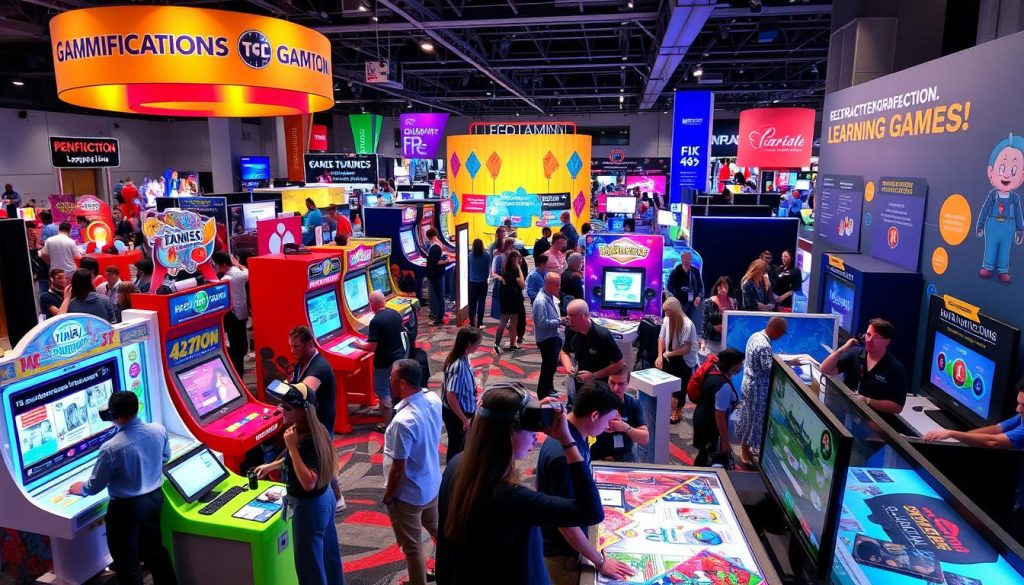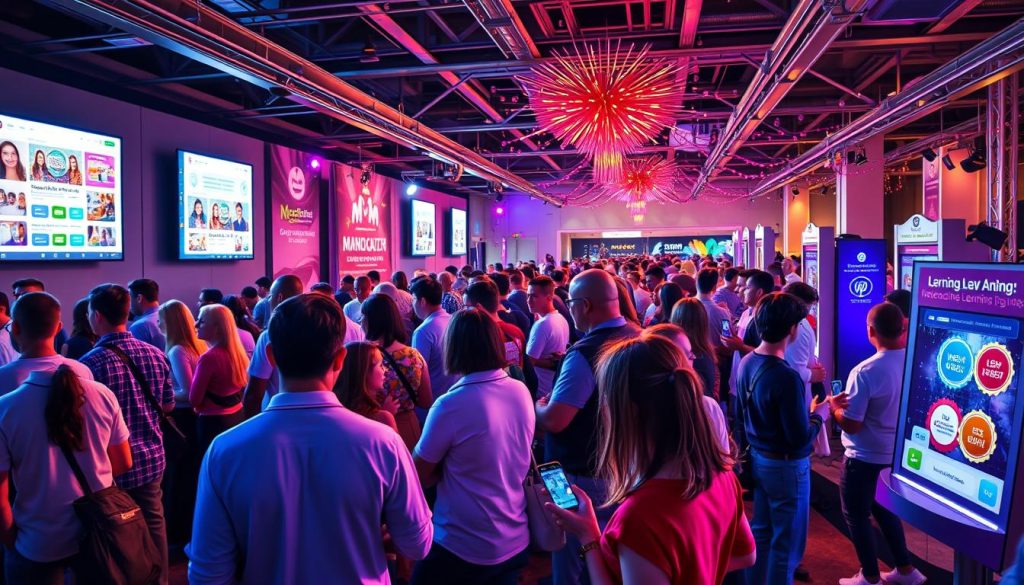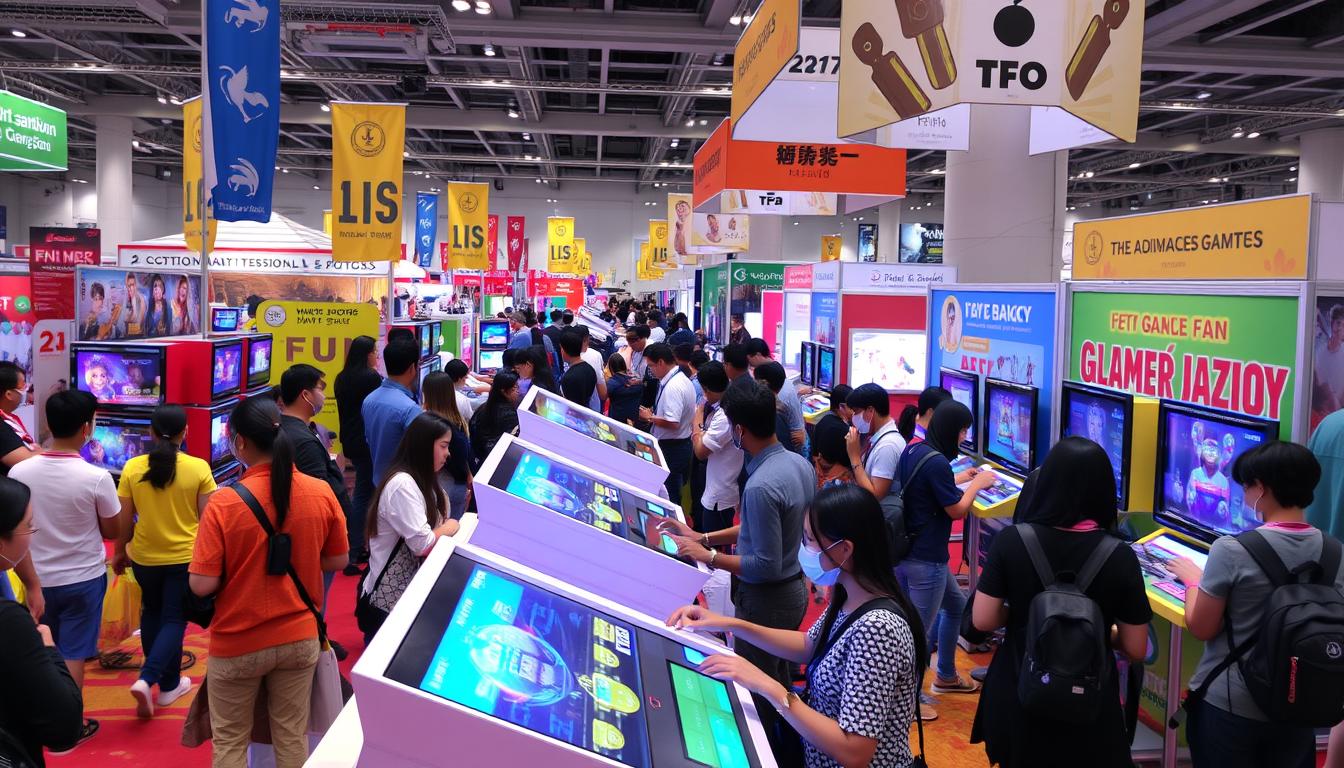Expos are buzzing hubs of knowledge and networking. But how do you keep attendees engaged and eager to learn? The answer lies in gamification and interactive learning. These engaging experiences transform dry information into fun, memorable moments.
By blending education with entertainment, expos can create a dynamic atmosphere that captivates visitors. Gamification turns passive listeners into active participants, making learning feel like play. This approach not only boosts retention but also sparks curiosity and encourages exploration.
Interactive learning experiences at expos can range from digital quizzes to hands-on challenges. These activities tap into our natural love for games, making complex topics more approachable. As attendees compete, collaborate, and discover, they forge stronger connections with brands and ideas.
Key Takeaways
- Gamification enhances attendee engagement at expos
- Interactive learning makes complex information more digestible
- Engaging experiences boost information retention
- Games encourage active participation and exploration
- Blending education and entertainment creates memorable expo moments
Understanding the Power of Gamification in Event Engagement
Gamification transforms events into captivating experiences. By blending education with entertainment, it boosts audience participation and creates lasting impressions. Let’s explore how this powerful tool can revolutionize your next event.
The Psychology Behind Interactive Learning
Interactive learning taps into our natural desire for fun and achievement. When we play games, our brains release dopamine, enhancing memory and focus. This makes immersive education more effective than traditional methods.
Benefits of Combining Education with Entertainment
Mixing learning with fun creates a win-win situation. Attendees enjoy themselves while absorbing information. This approach leads to:
- Better retention of key concepts
- Increased engagement with content
- Higher motivation to participate
- Improved networking opportunities
Key Elements of Successful Event Gamification
Effective gamification relies on several crucial components:
- Clear objectives aligned with event goals
- Engaging storylines or themes
- Balanced challenge levels
- Meaningful rewards or recognition
- Social elements for collaboration
By incorporating these elements, you can create an experiential marketing strategy that captivates your audience and delivers memorable learning experiences.
“Gamification isn’t just about having fun; it’s about creating meaningful connections between people and content.”
How to Use Games to Educate and Entertain Expo Attendees
Expo organizers are turning to gaming for learning to boost attendee engagement. By implementing event gamification strategies, you can create memorable experiences that educate and entertain. Let’s explore how to make your expo a hit with interactive games.
Start by defining clear learning objectives. Your games should align with the expo’s theme and deliver valuable information. For example, a tech expo might feature a virtual reality puzzle that teaches coding basics.
Next, consider your audience. Different age groups and industries prefer varied game styles. A financial expo might use a stock market simulation, while a food expo could offer a cooking challenge game.
“Games are the most elevated form of investigation.” – Albert Einstein
Incorporate diverse game types to cater to various learning styles. Some options include:
- Trivia quizzes
- Scavenger hunts
- Role-playing simulations
- Augmented reality experiences
Don’t forget to leverage technology. Mobile apps and interactive touchscreens can enhance the gaming experience. Consider using lead generation strategies to capture attendee data through game participation.
Lastly, balance entertainment with education. Games should be fun but also provide valuable takeaways. Use a mix of quick, exciting challenges and more in-depth learning experiences.
| Game Type | Learning Objective | Engagement Level |
|---|---|---|
| VR Simulation | Practical Skills | High |
| Quiz Game | Knowledge Retention | Medium |
| Escape Room | Problem Solving | Very High |
By implementing these gaming for learning techniques, you’ll create an expo that’s both educational and entertaining, leaving a lasting impression on your attendees.
Creating Immersive Learning Experiences Through Interactive Activities
Immersive education takes center stage in modern event planning. Interactive learning transforms passive attendees into active participants, fostering engaging experiences that stick. Let’s explore how to craft these memorable moments.
Designing Custom Games for Different Learning Styles
Tailoring games to diverse learning styles ensures everyone benefits from interactive learning. Visual learners thrive with image-based puzzles, while kinesthetic learners enjoy hands-on simulations. Auditory learners excel in trivia-style contests that test their listening. By catering to various preferences, we create inclusive immersive education environments.
Incorporating Technology-Based Solutions
Technology amplifies engaging experiences. Virtual reality tours transport attendees to far-off locations. Augmented reality overlays bring static displays to life. Mobile apps facilitate real-time quizzes and polls, boosting participation. These tech-driven solutions elevate immersive education to new heights.
Balancing Fun and Educational Content
Striking the right balance between entertainment and education is crucial. Games should be enjoyable yet informative. Consider a scavenger hunt that requires participants to gather industry-specific facts. Or design a role-playing scenario where attendees solve real-world problems. This approach ensures learning remains fun and memorable, boosting retention and engagement.
| Learning Style | Game Type | Technology Used | Educational Benefit |
|---|---|---|---|
| Visual | Picture Puzzles | Touchscreen Displays | Improves Pattern Recognition |
| Auditory | Trivia Contests | Voice Recognition Software | Enhances Listening Skills |
| Kinesthetic | Virtual Simulations | VR Headsets | Develops Practical Skills |
| Reading/Writing | Digital Storytelling | Interactive E-books | Boosts Comprehension |
Implementing Digital Solutions for Attendee Engagement
Digital solutions revolutionize attendee engagement at expos. By leveraging technology-based solutions, event organizers create dynamic experiences that captivate audiences. These tools blend gamification and interactive learning, transforming passive attendees into active participants.
Mobile apps stand out as powerful engagement tools. They offer features like personalized schedules, real-time updates, and interactive maps. Some apps incorporate gamification elements, rewarding attendees for visiting booths or participating in activities.
Virtual reality (VR) and augmented reality (AR) technologies create immersive experiences. Attendees can explore products, participate in simulations, or engage with virtual environments. These technologies bridge the gap between physical and digital worlds, enhancing learning and retention.
Live polling and Q&A platforms foster active participation. They allow attendees to voice opinions, ask questions, and shape discussions in real-time. This interactivity keeps audiences engaged and provides valuable insights for speakers and organizers.
| Digital Solution | Engagement Method | Benefits |
|---|---|---|
| Mobile Apps | Gamification, Personalization | Increased participation, Better navigation |
| VR/AR | Immersive Experiences | Enhanced learning, Memorable interactions |
| Live Polling | Real-time Interaction | Active participation, Immediate feedback |
By integrating these digital solutions, expos transform into interactive learning hubs. Attendees enjoy engaging experiences while organizers gain valuable data on participation and preferences, creating a win-win scenario for all involved.
Strategies for Maximizing Audience Participation
Boosting audience participation is key to creating engaging experiences at expos. Let’s explore effective event gamification strategies to get attendees involved and excited.
Building Community Through Group Activities
Group activities foster connections among attendees. Team challenges, collaborative problem-solving tasks, and interactive workshops encourage networking while reinforcing learning objectives. These shared experiences create a sense of community that enhances overall engagement.
Creating Competitive Elements
Friendly competition drives participation. Leaderboards, timed challenges, and quizzes spark attendees’ competitive spirit. Tailoring content for specific groups ensures these competitive elements resonate with diverse audiences.
Developing Reward Systems
Incentives motivate attendees to participate fully. Consider these reward options:
| Reward Type | Examples | Benefits |
|---|---|---|
| Digital Badges | Achievement icons, Level-up markers | Visual progress tracking, Shareable on social media |
| Physical Prizes | Branded merchandise, Gift cards | Tangible incentives, Increased brand recall |
| Exclusive Access | VIP sessions, Early product previews | Enhanced learning opportunities, Feeling of prestige |
By implementing these strategies, event organizers can create a dynamic atmosphere that encourages active participation and memorable learning experiences for all attendees.
Measuring Success and ROI of Interactive Learning Games
Tracking the success of gaming for learning initiatives is crucial for refining your event gamification strategies. By evaluating key metrics, you can gauge the effectiveness of your interactive activities and justify your investment in these innovative approaches.
Key Performance Indicators
To measure the impact of your gamification efforts, focus on these KPIs:
- Participation rates
- Knowledge retention scores
- Engagement duration
- Social media mentions
- Lead generation numbers
Data Collection Methods
Gather valuable insights through various data collection techniques:
- In-game analytics
- Post-event surveys
- Badge or point systems
- Social media monitoring

Analyzing Attendee Feedback
Dive deep into attendee responses to refine your approach. Look for patterns in feedback to identify strengths and areas for improvement in your event gamification strategies. This analysis helps tailor future games to boost audience participation and learning outcomes.
“The true measure of success in interactive learning games lies not just in numbers, but in the lasting impact on attendees’ knowledge and engagement.”
By carefully examining these metrics and feedback, you can continually enhance your gaming experiences, ensuring they deliver both educational value and entertainment for your expo attendees.
Best Practices for Event Gamification Success
Gamification has revolutionized the way we approach event engagement. By implementing interactive learning and creating engaging experiences, organizers can captivate attendees and boost knowledge retention. Let’s explore some proven strategies for event gamification success.
First, design games that align with your event’s goals. Whether it’s networking, education, or product showcases, tailor your gamification elements accordingly. This approach ensures that fun activities contribute meaningfully to the overall event experience.
Next, keep it simple. Overly complex games can frustrate participants and hinder engagement. Opt for intuitive mechanics that allow attendees to jump in quickly and enjoy the experience without extensive instructions.
Balancing competition and collaboration is crucial. While leaderboards can spark healthy rivalry, team-based challenges foster cooperation and networking among attendees. This mix creates a dynamic atmosphere that appeals to different personality types.
Incorporate varied game types to cater to diverse learning styles. Some attendees might prefer quizzes, while others thrive in scavenger hunts or role-playing scenarios. Offering a range of options ensures broader participation and engagement.
“Effective gamification isn’t about playing games; it’s about creating meaningful experiences that drive desired behaviors and outcomes.”
Lastly, leverage technology to enhance your gamification efforts. Mobile apps, augmented reality, and interactive displays can elevate the gaming experience and make it more immersive for participants.
| Gamification Element | Benefits | Implementation Tips |
|---|---|---|
| Points System | Motivates participation | Reward various activities, not just wins |
| Leaderboards | Encourages friendly competition | Update in real-time for excitement |
| Challenges | Promotes active learning | Align with event themes and goals |
| Rewards | Incentivizes engagement | Offer meaningful prizes or experiences |
Integrating Social Media with Interactive Learning Games
Social media platforms offer powerful tools for boosting audience participation and enhancing experiential marketing at expos. By seamlessly blending social media with interactive learning games, event organizers can create a dynamic environment that extends beyond the physical event space.
Leveraging Social Platforms for Enhanced Engagement
Social media integration amplifies event gamification strategies, creating a buzz that reaches far beyond attendees. Platforms like Facebook, Instagram, and Twitter can host live quizzes, polls, and challenges that complement on-site activities. This approach not only increases engagement but also enhances customer interaction and brand visibility.
Creating Shareable Moments
Encouraging attendees to share their experiences on social media can significantly boost event exposure. Design photo-worthy installations, create custom hashtags, and offer incentives for sharing. These tactics turn participants into brand ambassadors, extending the reach of your event gamification strategies.

Building Online Communities
Fostering online communities around your event keeps the conversation going long after the expo ends. Use social media groups or forums to continue discussions, share resources, and maintain connections made during the event. This ongoing engagement reinforces learning and strengthens relationships formed through interactive experiences.
| Social Platform | Engagement Strategy | Benefits |
|---|---|---|
| Live Q&A sessions | Real-time interaction, broad reach | |
| Photo contests | Visual engagement, user-generated content | |
| Hashtag challenges | Trend potential, quick dissemination | |
| Professional networking games | B2B connections, industry-specific engagement |
Conclusion
Gamification has become a powerful tool to educate and entertain expo attendees. By blending interactive learning with fun activities, events can create memorable experiences that boost engagement and knowledge retention. The key to success lies in designing games that balance educational content with entertainment value.
Throughout this article, we’ve explored how to use games to educate and entertain expo attendees effectively. From understanding the psychology behind interactive learning to implementing digital solutions, the strategies discussed can transform passive attendees into active participants. By incorporating technology-based solutions and creating immersive experiences, expos can cater to different learning styles and preferences.
As we’ve seen, measuring success is crucial for refining gamification strategies. By analyzing attendee feedback and tracking key performance indicators, event organizers can continuously improve their interactive learning games. Remember, the goal is to create an environment where learning feels effortless and enjoyable, leaving attendees excited to return for more.
FAQ
What is gamification in the context of expo events?
Gamification in expo events refers to the use of game-like elements and mechanics to create engaging, interactive experiences for attendees. It combines education with entertainment to enhance learning, increase participation, and make the overall expo experience more enjoyable and memorable.
How can games help educate expo attendees?
Games can help educate expo attendees by providing interactive learning experiences that make information more engaging and easier to retain. They can simulate real-world scenarios, encourage problem-solving, and offer immediate feedback, all of which contribute to a more effective learning process.
What are some examples of games that can be used at expos?
Some examples of games that can be used at expos include quiz competitions, scavenger hunts, virtual reality simulations, interactive product demonstrations, role-playing scenarios, and digital puzzle-solving challenges. The key is to align the game with the expo’s objectives and the attendees’ interests.
How can technology be incorporated into expo games?
Technology can be incorporated into expo games through various means, such as mobile apps, augmented reality (AR), virtual reality (VR), touchscreen displays, and RFID-enabled activities. These technology-based solutions can create immersive experiences, facilitate data collection, and enhance the overall interactivity of the games.
What are the benefits of using games for expo attendees?
The benefits of using games for expo attendees include increased engagement, improved information retention, enhanced networking opportunities, a more enjoyable expo experience, and the potential for personalized learning. Games can also help break the ice and create a more relaxed atmosphere for interaction.
How can expo organizers measure the success of their gamification efforts?
Expo organizers can measure the success of their gamification efforts by tracking key performance indicators (KPIs) such as audience participation rates, time spent engaging with games, knowledge retention scores, social media engagement, and attendee feedback. Post-event surveys and data analysis can provide valuable insights into the effectiveness of the games.
How can social media be integrated with expo games?
Social media can be integrated with expo games by creating shareable moments, encouraging attendees to post about their game experiences, incorporating social media challenges into the games, and building online communities around the expo’s themes. This integration can extend the reach of the event and foster continued engagement.
What are some best practices for implementing games at expos?
Some best practices for implementing games at expos include aligning games with learning objectives, designing for different learning styles, balancing fun and educational content, incorporating competitive elements, developing reward systems, and ensuring games are accessible to all attendees. It’s also important to test games thoroughly before the event.
How can games be designed to cater to different learning styles?
Games can be designed to cater to different learning styles by offering a variety of formats and interactions. For visual learners, incorporate graphics and videos; for auditory learners, include narration and sound effects; for kinesthetic learners, design hands-on activities. Providing options allows attendees to engage in ways that best suit their learning preferences.
Can gamification strategies be applied to virtual or hybrid expos?
Yes, gamification strategies can definitely be applied to virtual or hybrid expos. Online platforms offer numerous opportunities for interactive learning and engagement through digital games, virtual scavenger hunts, online quizzes, and collaborative challenges. These strategies can help bridge the gap between in-person and remote attendees in hybrid events.


